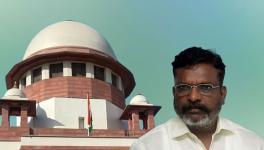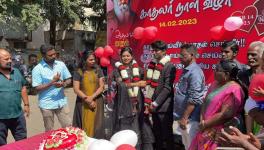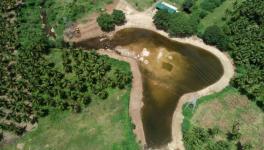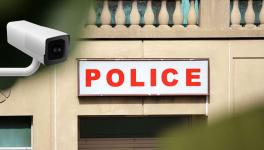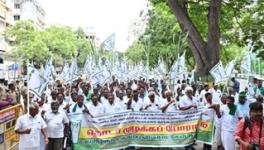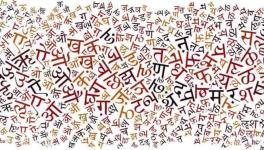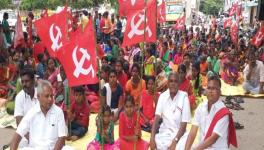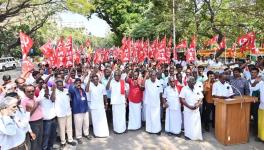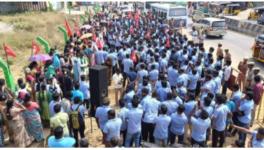Is TN Govt’s Martyr Memorial for 21 Police Firing Deaths Manipulating History?
1987 Vanniyar reservation protest. Image courtesy: Frontline
In the recently concluded Tamil Nadu budget session, several memorials and statues were announced in honour of various personalities from history. The names that feature in the list inevitably reflect the ruling party Dravida Munnetra Kazhagam (DMK)’s principles and politics.
One such memorial is in honour of the 21 people who died in a police firing on September 17, 1987, as part of the agitation for special reservations for the Vanniyar community. The memorial would come up in Villupuram district at a cost of Rs 4 crore.
Making the announcement Chief Minister MK Stalin said “it is the objective of the DMK government to protect the rights of the oppressed sections”.
Welcoming the move, S Ramadoss, founder of the vanniyar majority party Paattali Makkal Katchi (PMK) termed the agitations as the biggest struggle in India for social justice. Additionally, he said there must be social justice for everyone in Tamil Nadu and that his party would work towards it without any hindrance.
The history of the agitations and the implications of it can be found here.
But, that’s not all. The Vanniyar agitations for special reservation were violent in nature and helpless Dalits were the ones predominantly on the receiving end. This aspect of the agitations are completely wiped out from history and a rosy picture of Vanniyar struggle for social justice is upheld by the DMK government.
The announcement was likely made in an effort to tap into Vanniyar votes ahead of the local body elections in nine districts and to attract the PMK towards the DMK-alliance. The Congress floor leader, K Selvaperunthagai even wooed the PMK to the alliance led by the DMK.
However, upholding an agitation that was innately anti-Dalit questions DMK’s notion of social justice.
MEMORIAL FOR ANTI-DALIT RIOTERS?
After the announcement of the memorial was made in the assembly, senior DMK leader Durai Murugan gave an emotional speech appreciating the move. He said that “the announcement was an expression of Stalin's principles” and “the move of erecting a memorial is a means for recalling history and teaching them to our children”.
What is their history? And,what are the principles reflected in upholding it?
During the mid and late 1980s, Vanniyars had mobilised against the government seeking special reservation based on social and economic backwardness. Yet, the main targets of the Vanniyar Sangam, the group that led the struggle, were the unfortunate Dalits. Notably, Vanniyars have much in common with Dalits, especially poverty and backwardness.
An article published in the India Today newspaper, in October 1987, read “Angry Vanniyar mobs also entered Harijan colonies in South Arcot and set ablaze hundreds of huts”, besides other forms of violence and road blocks. The article goes on to read “the agitation has brought the Vanniyars a bad name because of their attacks on the Harijans”.
MP of Viduthalai Chiruthaigal Katchi (VCK, formerly known as Dalit Panthers of India) Ravikumar asks “can all the people who died in a police firing be elevated to martyr status? This could become a negative trend”.
VCK is presently part of the DMK alliance, and has on various occasions stated that its immediate goal is to counter the growing right-wing forces. The other big regional party, AIADMK, is in alliance with the right-wing BJP.
Udhaya Kumar, a senior CPI(M) activist from Villupuram district, where the agitation took place, said referring to the memorial “I am not able to understand why DMK is doing this. Dalit groups may keep quiet now, but the move would surely have its repercussions”. “In fact the Vanniyar movement has intensified its anti-Dalit stand since the agitatons for reservations” he added.
DMK USING HISTORY FOR PRESENT GAINS?
The then AIADMK government resorted to police repression in response to The Vanniyar agitation in 1987, leaving 21 dead. Consequently, an anti-AIADMK sentiment emerged, which the succeeding DMK-led government sought to use to its advantage.
Chief minister M Karunanidhi stopped the Backward Class (BC) survey and directly pushed for compartmental reservation within the BCs, and thereby partly fulfilling the Vanniyar Sangam demand.
The DMK government passed pensions for family members of the deceased, and martyr columns were erected in various spots in memory of the dead.
Thirty four years after the riots, the DMK continues to profit from the same agitations. September 17, 1987 is an important day for the Vanniyars. Local gatherings and protests are held every year and those who gave their lives to the cause are commemorated.
CM Stalin promised education as well as qualification-based government jobs for family members of those killed in the agitation that was led by the Vanniyar Sangam.
MP Ravikumar remarked “pensions to the families of the deceased was a good move by the DMK and is acceptable”. But he went on to ask “DMK has already given martyr columns for the deceased in different spots, what is the need for a separate memorial? On September 17 Villupuram remains tense, a distinct memorial gives space to mobilise a single caste in large numbers in one place that could have its consequences”.
He further added, “Instead, given that Vanniyars are an economically and educationally backward community, setting up universities would be more constructive. Speaking in the larger interest, I would say that a lot more can be done for the backward classes.”
WHAT ABOUT THE ATTACK ON DALITS?
Although the Sangam raked riots and attacked Dalit neighbourhoods, they got a large part of what they were fighting for, along with the expansion of their organisation.
Moreover, The Vanniyar Sangam leaders took no responsibility for the death of the 21 youngsters, instead they went on to build their organisation, gaining from the death of their cadre. Udhaya Kumar said “in fact the Vanniyar Sangam did nothing for the families of the dead. Many of the family members left the movement after the unexpected killings”.
Bringing together some 27 local Vanniyar organisations - with a younger, militant and educated leadership - but highly vulnerable cadres, the Sangam experienced phenomenal growth since 1986, particularly in the northern districts of Tamil Nadu. It eventually evolved into the political party PMK.
The Vanniyar agitations triggered vociferous claims and counter-claims from many other caste and communal organisations for their share of reservation benefits. Claims were made based on inflated estimates of their numerical strength in the state’s population in the hope that they may also get similar gains.
All of this leads on to one question: Whither social justice?
Get the latest reports & analysis with people's perspective on Protests, movements & deep analytical videos, discussions of the current affairs in your Telegram app. Subscribe to NewsClick's Telegram channel & get Real-Time updates on stories, as they get published on our website.










